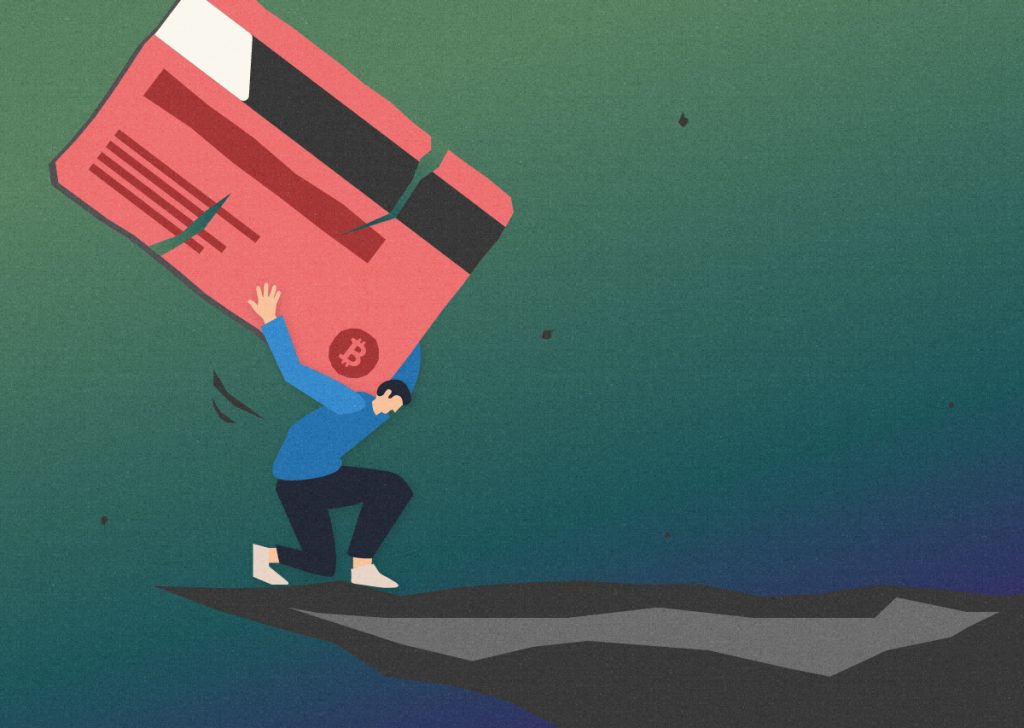All illustrations by Jasmine Ho for RICE Media.
Ong didn’t dive into the world of crypto because of hype. He just wanted a nice cashback credit card.
The 32-year-old is better known as the financial blogger KPO, short for Kiam Pok Ong. The Hokkien nickname he chose means thrifty or stingy – “depending on how you look at it”, he explains with a laugh.
On his blog, Ong and his wife, known to readers as CZM (Chan Zui Mao or ‘glutton cat’ in Chinese), regularly documented snippets of their lives. They wrote about money-saving tips, insights into their stock trades, and, eventually, the biggest financial disaster of their lives.
When they welcomed their first child in 2020, Ong noticed a significant increase in his monthly expenditure. On better days, Ong usually found a way to turn his daily spending into something useful, like redeemable mileage for flight upgrades. But when COVID-19 disrupted international travel, that became out of the question. He needed another kind of cashback card.
He hunted around and found a well-known cryptocurrency exchange. Through its app, Ong learnt that users could earn rewards via virtual currencies. That quickly stole Ong’s attention.
“My wife disagreed,” Ong recalls. “She doesn’t believe in crypto and emphasised that she will not be contributing to it.”
In hindsight, he should’ve listened.
“I thought I opened a door of opportunity. Instead, it was a door leading to mistakes–ones that affected not only me, but many others.”
Down the Rabbit Hole
Having started investing in 2014 as an undergraduate student, Ong sees himself as a veteran when it comes to generating passive income—a world that promises big rewards for seemingly little work.
“I believe it’s important to manage one’s finances, letting your money work for you and having long-term goals,” Ong wrote in one blog entry.
Indeed, the concept of spending may seem almost non-existent in Ong’s life. In the army, his friends would dash to the canteen as a reprieve from the drudgery of camp meals, no matter the cost. Ong, however, saved his money and chose to eat only in the cookhouse. Even after he started earning a stable salary from, the man only eats home-cooked food.
By age 24, Ong was able to enter the market with $40,000 accumulated over the years from savings out of his NS allowance, part-time work, and pocket money.
His ultimate goal: Earn a passive income of $5,000 a month before he retires.
As his parents had already set aside a plan to pay for his higher education, he didn’t need to worry about tuition fee loans when he graduated in 2015.
The following year, Ong inherited $50,000 from his grandfather. With an aggressive approach to investing, all of it went to investments.
From the get-go, Ong declared to his blog readers that he had not undergone any formal finance education or training. For many of the single stocks he was trading through brokerages, he did not always see profit. Some even failed miserably.
As a complete novice in the realm of cryptocurrencies, investing in them was an even riskier decision.
Nonetheless, he continued seeking higher cashback rewards from his expenses—he was determined to let his family live happily and comfortably. Besides, he had chanced upon another financial blogger, AK, whose blog entries convinced him to take on greater risks for larger profits.
As an investment route, cryptocurrency seemed to offer what Ong wanted. Singapore authorities had detailed ambitions to become a crypto hub. The industry enjoyed rapid growth from US$5.2 billion in market capitalisation in 2015 to more than US$2 trillion in August 2021. Those are big, promising numbers.
At the start, he set a limit: no more than one percent of his net worth.
“For example, if my net worth is a million dollars, I am not going to invest more than $10,000 in crypto,” Ong says. “Even if my value drops or increases, I will not change the amount I set to invest.”
Then, that plan unravelled. As soon as Ong got comfortable with trading on the crypto platform, he became more and more ambitious. Reckless, even.

Lured by platforms which advertised minimal admin fees and interest rates as high as 8.6 percent, Ong just kept buying in.
Gradually, he owned “keys” (secure codes for cryptocurrency transactions) and traded at the blockchain level. This meant he was truly getting into riskier territory, even for professional crypto traders.
Within a year, 53 percent of his investment portfolio was in cryptocurrency, a far cry from the initial plan of 1 percent.
Then, in May 2022, came the crypto crash.
Crypto Crash Catastrophe
At the peak of Ong’s investments in March 2022, his crypto portfolio was worth $2.4 million. In addition, he held more than $100,000 worth of non-fungible tokens (NFTs).
Ong also started a crypto business with two friends. It was built on Terra, a platform created in 2018 that hosts TerraUSD (UST), one of the world’s largest stablecoins.
Terra’s co-founder, Do Kwon, was famous (or infamous) for his ferocious confidence in the network, which often drew heat from rival crypto investors and criticism from industry sceptics.
In March 2022, UST’s sister token, LUNA, surged to rank among the top 10 largest cryptocurrencies by market cap.
From the outside, whatever Do Kwon was doing appeared to be working. Ong and his business partners were drawn to that.
The trio collectively held more than 10,000 UST and LUNA.
By its nature, the value of cryptocurrency isn’t stable. Crypto values can fluctuate wildly depending on various factors: investor sentiment, media hype and government policies. In the case of UST-LUNA, if a particular cryptocurrency is pegged to gold or the US dollar, it offers investors some confidence.
But this sense of security was severely blown on 7 May 2022, when people started selling off their UST.
This was triggered by a mysterious sale of US$350 million worth of UST. It was followed by a withdrawal of US$150 million UST by Terra, which claimed it was meant to prepare for a new launch project.
Still, these big moves triggered bigger panic. Rumours began spreading on Twitter. Some investors speculated that it could mark the start of UST-LUNA’s fall.
Ong, however, remained unfazed.
“You can say I was blinded by faith,” he recalls. “I thought the balance would eventually be restored and everything would be all right again.”
Ong’s confidence at the time was not completely baseless—at least to the crypto evangelists. Unlike other cryptocurrencies, UST-LUNA was supposed to be less volatile and vulnerable.
Terra kept track of its supply and demand through complex algorithms that its creators were proud of—albeit a little too proud.
Besides, with the crypto exchange, Ong believed he had found exactly what he wanted: a useful cashback credit card, this time using his UST-LUNA assets for regular expenditures like groceries, which his wife handled.
It felt like their crypto investment plan was working. It just didn’t last long.
By June 2022, the accumulated selling pressure led to a dramatic plunge in the values of UST and LUNA.
On the day of the crash, Ong had to apply for urgent leave from work. He sat down to call his boss, confessing that he could not function at work while knowing his investment had dropped to zero overnight.
“That was the longest and toughest week for me and my wife,” he recalls.
He had grand plans for his family: a property near a good school and a second property for his wife to generate more passive income.
“Everything vanished just like that,” Ong continues. He blames himself for being too greedy.
Ong’s wife, on the other hand, wishes she had held Ong back. She has since become financially insecure and now longs to return to work.
In the weeks that followed the crash, the couple’s financial and emotional states were on particularly shaky ground.
They had to start using cash to pay for the portion of their daily expenses that were previously covered by crypto. They also regretted not buying a car and not spending some of the money they had earned, which could have minimised their losses.
“I would cry over the most random stuff,” Ong adds. “I had believed that it was all my fault. Investing in crypto made me lose my head.”
Safe Buffer
The silver lining is that while Ong was diving deep into the world of crypto, he had, in fact, also started investing in traditional assets such as stocks and bonds.
He did so through Endowus, a Singapore-based digital wealth platform. Endowus advises and builds investment portfolios that suit each individual.
While some may avoid such new platforms, Ong thought of it as a safe option — safe enough to invest his retirement money from his CPF and SRS accounts, and park it there for the long run.

“It was just money that I set aside and forgot about,” he says.
This meant that not all of his money was lost. While he hasn’t touched cryptocurrencies since the crash, his investments in traditional assets have continued to stand the test of time.
Crypto isn’t regulated. But in the world of finance, it’s an outlier. Ong’s traditional equity investments under Endowus have, instead, given him peace of mind. The platform tailored an investment plan for him and provided advice based on his financial goals, timeline, and risk appetite.
In short—no urgent leave calls required.
Ong has since come to terms with his financial loss. He is also taking a break from blogging.
But there was something else to address.
A Painful Lesson
In one of his last blog entries, Ong mentioned a local police report filed against Do Kwon. The report mentioned several online articles, including a step-by-step guide written by Ong on how he earned passive income through crypto.
He rounded up the post by writing: “What’s stopping you from exploring crypto? If Mark Lee (李国煌) can DeFi, so can you. lol.”
Ong feels the weight of guilt. He still can’t get over the fact that he had encouraged his readers—some of whom had shown him tremendous support over the years—to venture into crypto.
He thinks that if his readers were badly affected by the crypto collapse, he should be the first to be blamed.
Months after that step-by-step guide was published, Ong wrote a new post. He cautioned people not to read and learn about investing and personal finance from someone who has lost so much money. Basically, himself.
“I mean, come on, who wants to learn from a financial blogger who lost $2 million?” he says.
“But no matter what, life goes on, whether you lose money or not. So, always remember you shouldn’t see money as the main aspect of life. You still have your family, health and other important things worth your attention.”
“A $2 million life lesson is too painful for anyone.”







